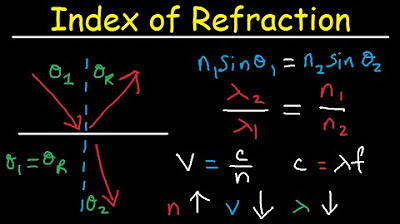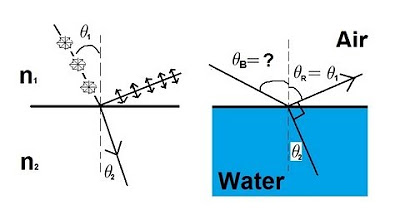Physics 52 Refraction and Snell's Law (9 of 11) Ex. 4: Light Through a Prism
TLDRThis script explores a classic problem involving Snell's law and refraction through a 60° equilateral glass prism. It details the process of determining the exit angle of light, starting with an incident angle of 40° relative to the normal. By sequentially applying Snell's law at each boundary, the script calculates intermediate angles, revealing the exiting light's direction as 35.6° below the horizontal. The explanation emphasizes understanding internal angles and the refraction process, offering a clear guide for students to solve similar problems.
Takeaways
- 🔍 The problem involves light passing through a 60°-60°-60° equilateral glass prism using Snell's law and the concept of refraction.
- 📐 The angle of incidence is 40° relative to the normal of the prism's surface, calculated from the given 10° below the horizontal and the 30° angle of the prism's face.
- 🌟 Snell's law is applied to find the angle of refraction at the first boundary, using the formula \( n_1 \sin(\theta_1) = n_2 \sin(\theta_2) \).
- 🔢 The refractive index (N1) outside the prism is 1, and inside the prism (N2) is 1.56, leading to the calculation of the first refraction angle (Theta2) as 24.3°.
- 📏 Knowing the prism's geometry, the angle between the refracted light and the horizontal is determined to be 5.7°, as the light bends below the horizontal.
- 🔄 The second refraction occurs at the prism's exit, where the angle of incidence (Theta3) is calculated to be 35.7° considering the prism's geometry and the previous refraction.
- 📚 Snell's law is again used at the second boundary to find the exiting angle (Theta4), with the refractive index outside the prism (N4) being 1.
- 🧭 The final angle of the refracted light as it exits the prism (Theta4) is calculated to be 65.6° relative to the normal.
- 📉 The exiting light's angle relative to the horizontal is found by subtracting the prism's face angle from Theta4, resulting in 35.6° below the horizontal.
- 🤓 The problem is considered challenging for students, particularly in visualizing and calculating the internal angles within the prism.
- 🔚 The script provides a step-by-step guide to solving the problem, emphasizing the importance of understanding Snell's law and the geometry of the prism.
Q & A
What is the shape of the prism discussed in the script?
-The prism discussed in the script is an equilateral prism with all sides and angles being equal.
What is the angle of incidence of the light beam relative to the normal?
-The angle of incidence of the light beam is 40° relative to the normal of the surface.
Why is the angle of incidence considered to be 40°?
-The angle of incidence is considered to be 40° because the light beam is 10° below the horizontal, and the normal is at an angle of 30° with the horizontal, making the effective angle of incidence 40°.
What is Snell's law and how is it used in this context?
-Snell's law relates the angles of incidence and refraction to the indices of refraction of two different media. It is used here to calculate the angle of refraction when light passes from one medium to another.
What is the index of refraction used for the first medium (N1) and the second medium (N2)?
-The index of refraction for the first medium (N1) is 1, and for the second medium (N2), it is 1.56, which is typical for glass.
How is the angle of refraction (Theta2) calculated using Snell's law?
-Theta2 is calculated using the formula: Theta2 = arcsin((N1 * sin(Theta1)) / N2), where N1 and N2 are the indices of refraction and Theta1 is the angle of incidence.
What is the calculated angle of refraction (Theta2) when the light enters the prism?
-The calculated angle of refraction (Theta2) when the light enters the prism is 24.3°.
Why is the angle between the refracted beam and the horizontal less than the angle of incidence?
-The angle between the refracted beam and the horizontal is less than the angle of incidence because the index of refraction of the second medium (glass) is higher than the first (air), causing the light to bend towards the normal.
How is the angle of incidence (Theta3) at the second boundary calculated?
-Theta3 is calculated by considering the geometry of the prism and the angles involved. It is the sum of the angle between the normal and the horizontal (30°) and the angle between the horizontal and the refracted beam (5.7°), resulting in 35.7°.
What is the final angle of the refracted light (Theta4) as it leaves the prism?
-The final angle of the refracted light (Theta4) as it leaves the prism is 65.6° relative to the normal, which translates to 35.6° below the horizontal.
What additional insight can be gained from the problem-solving process described in the script?
-The problem-solving process demonstrates the importance of understanding the geometry of the prism and the application of Snell's law to determine the path of light through different media, highlighting the relationship between angles of incidence, refraction, and the indices of refraction.
Outlines
🔍 Analyzing Light Refraction in a 60° Equilateral Glass Prism
This paragraph discusses a classic problem involving Snell's law and the refraction of light through a 60° equilateral glass prism. It begins with an incident light beam at a 40° angle to the prism's surface normal. The goal is to determine the angle at which the light exits the prism, denoted as Theta sub4. The process involves applying Snell's law at the first boundary with indices of refraction 1 and 2, calculating the angle of refraction (Theta sub2) to be 24.3°. The paragraph explains the geometric relationships and the subsequent refraction at the second boundary, considering the prism's angles and the light's path.
📐 Calculating the Exit Angle of Light from a Prism
The second paragraph continues the analysis by focusing on the light's interaction with the second boundary of the prism. It calculates the incident angle (Theta sub3) as 35.7° by considering the prism's geometry and the previously determined angles. The paragraph then applies Snell's law again to find the exiting angle of refraction (Theta sub4), using the indices of refraction for the glass (1.56) and air (1). The calculation results in an exiting angle of 65.6° relative to the normal. The summary explains the steps taken to solve for Theta sub4 and the geometric reasoning behind the light's path as it exits the prism.
🧭 Determining the Final Direction of Refracted Light
The final paragraph wraps up the problem by translating the exiting angle of refraction (Theta sub4) from being relative to the normal to the horizontal plane. It explains that by subtracting the 30° angle between the normal and the horizontal, the angle of the refracted light with respect to the horizontal is found to be 35.6° below the horizontal. This paragraph emphasizes the importance of understanding the internal angles within the prism and provides a clear conclusion to the problem, summarizing the light's path and the method used to determine the final direction of the refracted beam.
Mindmap
Keywords
💡Snell's Law
💡Index of Refraction
💡Angle of Incidence
💡Angle of Refraction
💡Equilateral Prism
💡Normal
💡Arc Sine
💡Boundary
💡Horizontal
💡Theta
Highlights
Introduction of a classic problem involving Snell's law, index of refraction, and light refraction through a glass prism.
Description of the equilateral prism with angles of 60 degrees each.
Explanation of the angle of incidence being 40° relative to the normal of the surface.
Use of Snell's law to calculate the angle of refraction across the first boundary.
Calculation of the refracted light angle (Theta sub 2) as 24.3 degrees.
Understanding that the refracted light is below the horizontal due to the angle of refraction.
Identification of the angle between the refracted beam and the horizontal as 5.7 degrees.
Determination of the incident angle (Theta sub 3) at the second boundary as 35.7 degrees.
Application of Snell's law to find the exiting angle (Theta sub 4) of the refracted light.
Calculation of the exiting angle (Theta sub 4) as 65.6 degrees relative to the normal.
Conversion of the exiting angle to 35.6 degrees below the horizontal.
Emphasis on the difficulty students may face in determining the angles inside the prism.
Reiteration of the problem-solving steps for clarity and reinforcement.
Final summary of the exiting beam's direction as 35.6 degrees below the horizontal.
Highlighting the importance of understanding the angles relative to the normal and horizontal.
Demonstration of the problem-solving process in a step-by-step manner for educational purposes.
Transcripts
Browse More Related Video
5.0 / 5 (0 votes)
Thanks for rating:





